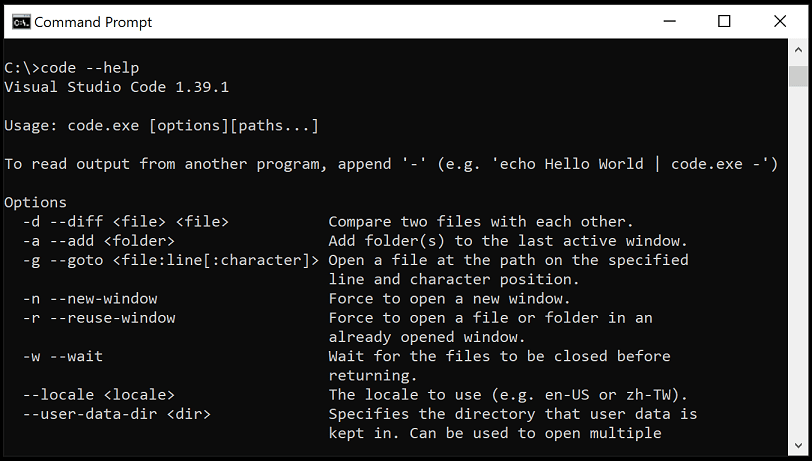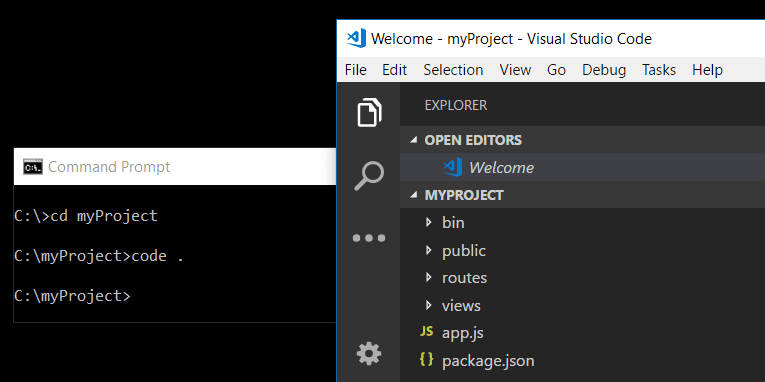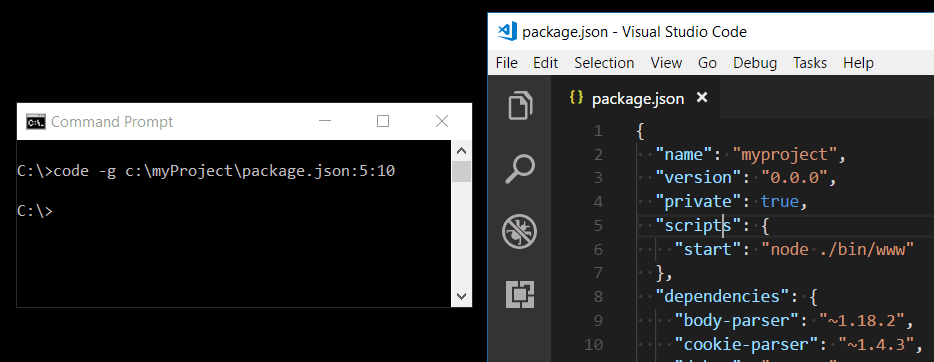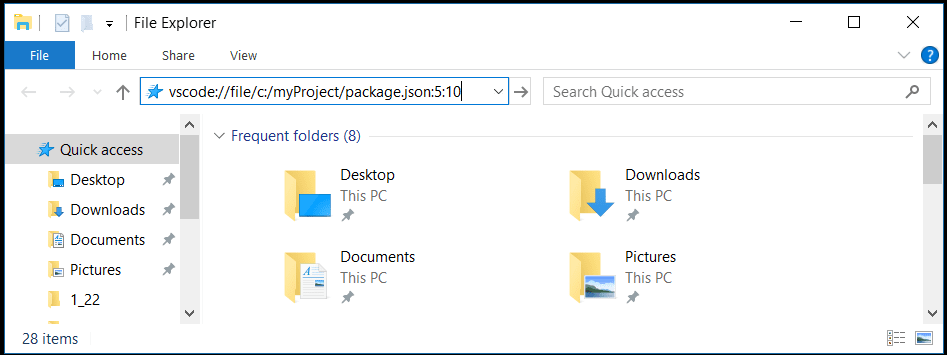Command Line Interface (CLI)
Visual Studio Code has a powerful command-line interface built-in that lets you control how you launch the editor. You can open files, install extensions, change the display language, and output diagnostics through command-line options (switches).

If you are looking for how to run command-line tools inside VS Code, see the Integrated Terminal.
Command line help
To get an overview of the VS Code command-line interface, open a terminal or command prompt and type code --help. You will see the version, usage example, and list of command line options.

Launching from command line
You can launch VS Code from the command line to quickly open a file, folder, or project. Typically, you open VS Code within the context of a folder. To do this, from an open terminal or command prompt, navigate to your project folder and type code .:

Users on macOS must first run a command (Shell Command: Install 'code' command in PATH) to add VS Code executable to the PATH environment variable. Read the macOS setup guide for help.
Windows and Linux installations should add the VS Code binaries location to your system path. If this isn't the case, you can manually add the location to the Path environment variable ($PATH on Linux). For example, on Windows, the default VS Code binaries location is AppData\Local\Programs\Microsoft VS Code\bin. To review platform-specific setup instructions, see Setup.
If you are using the VS Code Insiders preview, you launch your Insiders build with code-insiders.
Core CLI options
Here are optional arguments you can use when starting VS Code at the command line via code:
| Argument | Description |
|---|---|
-h or --help |
Print usage |
-v or --version |
Print VS Code version (for example, 1.22.2), GitHub commit ID, and architecture (for example, x64). |
-n or --new-window |
Opens a new session of VS Code instead of restoring the previous session (default). |
-r or --reuse-window |
Forces opening a file or folder in the last active window. |
- |
Read from stdin and open it in VS Code (for example, 'echo Hello World |
-g or --goto |
When used with file:line{:character}, opens a file at a specific line and optional character position. This argument is provided since some operating systems permit : in a file name. |
-d or --diff <file1> <file2> |
Open a file difference editor. Requires two file paths as arguments. |
-m or --merge <path1> <path2> <base> <result> |
Perform a three-way merge by providing paths for two modified versions of a file, the common origin of both modified versions, and the output file to save merge results. |
-w or --wait |
Wait for the files to be closed before returning. |
--locale <locale> |
Set the display language (locale) for the VS Code session. (for example, en-US or zh-TW) |

Opening Files and Folders
Sometimes you will want to open or create a file. If the specified file does not exist, VS Code will create them for you along with any new intermediate folders:
code index.html style.css documentation\readme.md
For both files and folders, you can use absolute or relative paths. Relative paths are relative to the current directory of the command prompt where you run code.
If you specify more than one file at the command line, VS Code will open only a single instance.
If you specify more than one folder at the command line, VS Code will create a Multi-root Workspace including each folder.
| Argument | Description |
|---|---|
file |
Name of a file to open. If the file doesn't exist, it will be created and marked as edited. You can specify multiple files by separating each file name with a space. |
file:line[:character] |
Used with the -g argument. Name of a file to open at the specified line and optional character position. |
folder |
Name of a folder to open. You can specify multiple folders and a new Multi-root Workspace is created. |
--skip-add-to-recently-opened |
Prevent the opened files and folders from being added to the recently opened list. |

Select a profile
You can launch VS Code with a specific profile via the --profile command-line interface option. You pass the name of the profile after the --profile argument and open a folder or a workspace using that profile. The command line below opens the web-sample folder with the "Web Development" profile:
code ~/projects/web-sample --profile "Web Development"
If the profile specified does not exist, a new empty profile with the given name is created.
Working with extensions
You can install and manage VS Code extensions from the command line.
| Argument | Description |
|---|---|
--install-extension <extension-id> | <extension-vsix-path> |
Install or update an extension. Provide either the full extension name publisher.extension or the path to a VSIX file as an argument. To install a specific version provide append @{version}. For example: vscode.csharp@1.2.3. Use --force argument to avoid prompts. Use --profile argument to install for a certain profile. |
--uninstall-extension <extension-id> |
Uninstall an extension. Provide the full extension name publisher.extension as an argument. Use --profile argument to uninstall for a certain profile. |
--disable-extensions |
Disable all installed extensions. Extensions will still be visible in the Disabled section of the Extensions view but they will never be activated. |
--list-extensions |
List the installed extensions. --profile argument can be used to list for a certain profile. |
--show-versions |
Show versions of installed extensions, when using --list-extensions |
--enable-proposed-api <ext> |
Enables proposed api features for an extension. Provide the full extension name publisher.extension as an argument. |
--update-extensions |
Update installed extensions and exit. |

Start chat from the command line
You can start a chat session directly from the command line by using the chat subcommand in the VS Code CLI. This enables you to open a chat session in your current working directory with a prompt you provide.
For example, the following command opens chat for the current directory and asks "Find and fix all untyped variables":
code chat Find and fix all untyped variables
The chat subcommand has the following command-line options:
-m,--mode <mode>: The custom agent to use for the chat session. Available options:ask,edit,agent, or the identifier of a custom agent. Defaults toagent.-a,--add-file <path>: Add files as context to the chat session.--maximize: Maximize the chat session view.-r,--reuse-window: Use the last active window for the chat session.-n,--new-window: Open an empty window for the chat session.
The chat subcommand also supports piping input from stdin by passing - at the end of the command. For example:
python app.py | code chat why does it fail -
Advanced CLI options
There are several CLI options that help with reproducing errors and advanced setup.
| Argument | Description |
|---|---|
--extensions-dir <dir> |
Set the root path for extensions. Overridden in Portable Mode by the data folder. |
--user-data-dir <dir> |
Specifies the directory that user data is kept in. Can be used to run multiple isolated instances of VS Code with separate environments, settings, and extensions. Also useful when running as root. Overridden in Portable Mode by the data folder. |
-s, --status |
Print process usage and diagnostics information. |
-p, --performance |
Start with the Developer: Startup Performance command enabled. |
--disable-gpu |
Disable GPU hardware acceleration. |
--verbose |
Print verbose output (implies --wait). |
--prof-startup |
Run CPU profiler during startup. |
--upload-logs |
Uploads logs from current session to a secure endpoint. |
--remote <authority> |
Connect to a remote development environment. The authority specifies the remote connection for WSL (wsl+<distro name> <path in WSL>) or for SSH (ssh-remote+<remote_server> <path on remote>). |
| Multi-root | |
--add <dir> |
Add folder(s) to the last active window for a multi-root workspace. |
--remove <dir> |
Remove folder(s) from the last active window for a multi-root workspace. |
Isolating VS Code instances
By default, VS Code instances share environment variables in the following way:
- If this is the first VS Code instance, environment variables are inherited from the parent process.
- If this is not the first VS Code instance, environment variables are inherited from the already running VS Code instance.
This behavior can cause issues when you need different environment variables for different projects or build configurations. For example, if you're working on two projects that require different versions of Node.js or different PATH settings.
To run VS Code instances with separate environment variables, use the --user-data-dir option to specify a unique user data directory for each instance:
# First instance with its own environment
code ~/project1 --user-data-dir ~/vscode-data-project1
# Second instance with different environment
code ~/project2 --user-data-dir ~/vscode-data-project2
Each instance with a different --user-data-dir will maintain its own:
- Environment variables
- Settings and preferences
- Installed extensions
- UI state and layout
When using --user-data-dir, you'll need to reinstall extensions for each user data directory, as extensions are stored separately.
Create remote tunnel
VS Code integrates with other remote environments to become even more powerful and flexible. Our goal is to provide a cohesive experience that allows you to manage both local and remote machines from one, unified CLI.
The Visual Studio Code Remote - Tunnels extension lets you connect to a remote machine, like a desktop PC or VM, via a secure tunnel. Tunneling securely transmits data from one network to another. You can then securely connect to that machine from anywhere, without the requirement of SSH.
We've built functionality into the code CLI that will initiate tunnels on remote machines. You can run:
code tunnel
to create a tunnel on your remote machine. You may connect to this machine through a web or desktop VS Code client.
You can review the other tunneling commands by running code tunnel -help:

As you may need to run the CLI on a remote machine that can't install VS Code Desktop, the CLI is also available for standalone install on the VS Code download page.
For more information on Remote Tunnels, you can review the Remote Tunnels documentation.
Opening VS Code with URLs
You can also open projects and files using the platform's URL handling mechanism. Use the following URL formats to:
Open a project
vscode://file/{full path to project}/
vscode://file/c:/myProject/
Open a file
vscode://file/{full path to file}
vscode://file/c:/myProject/package.json
Open a file to line and column
vscode://file/{full path to file}:line:column
vscode://file/c:/myProject/package.json:5:10
Open the Settings Editor
vscode://settings/setting.name
vscode://settings/editor.wordWrap
You can use the URL in applications such as browsers or file explorers that can parse and redirect the URL. For example, on Windows, you could pass a vscode:// URL directly to the Windows Explorer or to the command line as start vscode://{full path to file}.

If you are using VS Code Insiders builds, the URL prefix is vscode-insiders://.
Next steps
Read on to find out about:
- Integrated Terminal - Run command-line tools from inside VS Code.
- Basic Editing - Learn the basics of the VS Code editor.
- Code Navigation - VS Code lets you quickly understand and move through your source code.
Common questions
'code' is not recognized as an internal or external command
Your OS cannot find the VS Code binary code on its path. The VS Code Windows and Linux installations should have installed VS Code on your path. Try uninstalling and reinstalling VS Code. If code is still not found, consult the platform-specific setup topics for Windows and Linux.
On macOS, you need to manually run the Shell Command: Install 'code' command in PATH command (available through the Command Palette ⇧⌘P (Windows, Linux Ctrl+Shift+P)). Consult the macOS specific setup topic for details.
How do I get access to a command line (terminal) from within VS Code?
VS Code has an Integrated Terminal where you can run command-line tools from within VS Code.
Can I specify the settings location for VS Code in order to have a portable version?
Not directly through the command line, but VS Code has a Portable Mode, which lets you keep settings and data in the same location as your installation, for example, on a USB drive.
How do I detect when a shell was launched by VS Code?
When VS Code starts up, it may launch a shell in order to source the "shell environment" to help set up tools. This will launch an interactive login shell and fetch its environment. Depending on your shell setup, this may cause problems. For example, it may be unexpected that the shell is launched as an interactive session, which VS Code needs in order to try to align $PATH with the exact value in a user created terminal.
Whenever VS Code launches this initial shell, VS Code sets the variable VSCODE_RESOLVING_ENVIRONMENT to 1. If your shell or user scripts need to know if they are being run in the context of this shell, you can check the VSCODE_RESOLVING_ENVIRONMENT value.